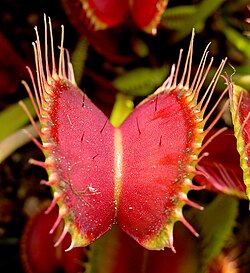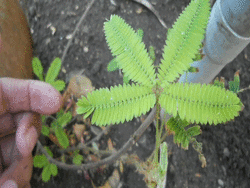Biology:Rapid plant movement

Rapid plant movement encompasses movement in plant structures occurring over a very short period, usually under one second. For example, the Venus flytrap closes its trap in about 100 milliseconds.[1] The traps of Utricularia are much faster, closing in about 0.5 milliseconds.[2] The dogwood bunchberry's flower opens its petals and fires pollen in less than 0.5 milliseconds. The record is currently held by the white mulberry tree, with flower movement taking 25 microseconds, as pollen is catapulted from the stamens at velocities in excess of half the speed of sound—near the theoretical physical limits for movements in plants.[3]
These rapid plant movements differ from the more common, but much slower "growth-movements" of plants, called tropisms. Tropisms encompass movements that lead to physical, permanent alterations of the plant while rapid plant movements are usually reversible or occur over a shorter span of time.
A variety of mechanisms are employed by plants in order to achieve these fast movements. Extremely fast movements such as the explosive spore dispersal techniques of Sphagnum mosses may involve increasing internal pressure via dehydration, causing a sudden propulsion of spores up or through the rapid opening of the "flower" opening triggered by insect pollination. Fast movement can also be demonstrated in predatory plants, where the mechanical stimulation of insect movement creates an electrical action potential and a release of elastic energy within the plant tissues. This release can be seen in the closing of a Venus flytrap, the curling of Sundew leaves, and in the trapdoor action and suction of bladderworts.[4] Slower movement, such as the folding of Mimosa pudica leaves, may depend on reversible, but drastic or uneven changes in water pressure in the plant tissues[5] This process is controlled by the fluctuation of ions in and out of the cell, and the osmotic response of water to the ion flux.[6]
In 1880 Charles Darwin published The Power of Movement in Plants, his second-to-last work before his death.
Plants that capture and consume prey
- Venus flytrap (Dionaea muscipula)
- Waterwheel plant (Aldrovanda vesiculosa)
- Bladderwort (Utricularia)
- Certain varieties of sundew (Drosera)
Plants that move leaves and leaflets
Plants that are able to rapidly move their leaves or their leaflets in response to mechanical stimulation such as touch (thigmonasty):

File:Codariocalyx motorius - Desmodium gyrans timelapse.webm
- Aeschynomene:
- Starfruit (Averrhoa carambola)[9]
- Biophytum:
- Biophytum abyssinicum[10]
- Biophytum helenae[11]
- Biophytum petersianum[12]
- Biophytum reinwardtii[13]
- Biophytum sensitivum
- Chamaecrista:
- Partridge pea (Chamaecrista fasciculata)
- Sensitive partridge pea (Chamaecrista nictitans)
- Chamaecrista mimosoides L.[14]
- Mimosa:
- Giant false sensitive plant (Mimosa diplotricha)
- Catclaw brier (Mimosa nuttallii)
- Giant sensitive plant (Mimosa pigra)
- Mimosa polyantha
- Mimosa polycarpa var. spegazzinii
- Sensitive plant (Mimosa pudica)
- Roemer sensitive briar (Mimosa roemeriana)
- Eastern sensitive plant, sensitive briar (Mimosa rupertiana)
- Mimosa uruguensis
- Neptunia:
- Yellow neptunia (Neptunia lutea)
- Sensitive neptunia (Neptunia oleracea)
- Neptunia plena
- Neptunia gracili
- Senna alata[14]
Plants that move their leaves or leaflets at speeds rapid enough to be perceivable with the naked eye:
- Telegraph plant (Codariocalyx motorius)
Plants that spread seeds or pollen by rapid movement
- Squirting cucumber (Ecballium elaterium)
- Cardamine hirsuta and other Cardamine spp. have seed pods which explode when touched.
- Impatiens (Impatiens)
- Sandbox tree
- Triggerplant (all Stylidium species)
- Canadian dwarf cornel (aka dogwood bunchberry, Cornus canadensis)
- White mulberry (Morus alba)[3]
- Orchids (all genus Catasetum)
- Dwarf mistletoe (Arceuthobium)
- Witch-hazel (Hamamelis)
- Some Fabaceae have beans that twist as they dry out, putting tension on the seam, which at some point will split suddenly and violently, flinging the seeds metres from the maternal plant.[15][16]
- Marantaceae[17]
- Minnieroot (Ruellia tuberosa)
- Peyote (Lophophora williamsii) stamens move in response to touch[18]
See also
References
- ↑ Forterre, Y., J.M. Skotheim, J. Dumais & L. Mahadevan 2005. "How the Venus flytrap snaps.". //www.oeb.harvard.edu/faculty/dumais/Publications/Nature2005.pdf. (318 KB) Nature 433: 421–425. doi:10.1038/nature03185
- ↑ "Carnivorous Plant Snaps Shut With 600 Gs" (in en). 16 February 2011. https://www.nbcnews.com/id/wbna41611513.
- ↑ 3.0 3.1 Taylor, P.E., G. Card, J. House, M. H. Dickinson & R.C. Flagan 2006. High-speed pollen release in the white mulberry tree, Morus alba L.. Sexual Plant Reproduction 19(1): 19–24. doi:10.1007/s00497-005-0018-9
- ↑ Poppinga, Simon; Weisskopf, Carmen; Westermeier, Anna Sophia; Masselter, Tom; Speck, Thomas (2016-01-01). "Fastest predators in the plant kingdom: functional morphology and biomechanics of suction traps found in the largest genus of carnivorous plants". AoB Plants 8: plv140. doi:10.1093/aobpla/plv140. PMID 26602984.
- ↑ Martone, Patrick T.; Boller, Michael; Burgert, Ingo; Dumais, Jacques; Edwards, Joan; Mach, Katharine; Rowe, Nick; Rueggeberg, Markus et al. (2010-11-01). "Mechanics without Muscle: Biomechanical Inspiration from the Plant World". Integrative and Comparative Biology 50 (5): 888–907. doi:10.1093/icb/icq122. ISSN 1540-7063. PMID 21558248. https://academic.oup.com/icb/article/50/5/888/644877/Mechanics-without-Muscle-Biomechanical-Inspiration.
- ↑ Forterre, Yoël (2013-11-01). "Slow, fast and furious: understanding the physics of plant movements". Journal of Experimental Botany 64 (15): 4745–4760. doi:10.1093/jxb/ert230. ISSN 0022-0957. PMID 23913956. https://academic.oup.com/jxb/article/64/15/4745/462045/Slow-fast-and-furious-understanding-the-physics-of.
- ↑ JSTOR Global Plants Compilation:Aeschynomene americana
- ↑ JSTOR Global Plants Compilation: Aeschynomene deightonii
- ↑ Missouri Botanical Garden: Averrhoa carambola
- ↑ JSTOR Global Plants Compilation: Biophytum abyssinicum
- ↑ JSTOR Global Plants Compilation: Biophytum helenae
- ↑ JSTOR Global Plants: Biophytum petersianum
- ↑ JSTOR Global Plants Compilation: Biophytum reinwardtii
- ↑ 14.0 14.1 The Gardens' Bulletin Singapore 49 (1) (1997)
- ↑ Tony D. Auld (1996). "Ecology of the Fabaceae in the Sydney region: fire, ants and the soil seedbank". Cunninghamia 4 (4): 531–551. https://www.rbgsyd.nsw.gov.au/__data/assets/pdf_file/0005/57848/Cun4Aul531.pdf. Retrieved 2009-03-13.
- ↑ Matt Lavin (2001). "Fabaceae". Macmillan Reference USA. //www.novelguide.com/a/discover/plsc_02/plsc_02_00131.html.
- ↑ "Marantaceae in Flora of North America @". Efloras.org. https://www.efloras.org/florataxon.aspx?flora_id=1&taxon_id=10535. Retrieved 2011-07-18.
- ↑ Lophophora blog: Thigmotropic stamens
 |

